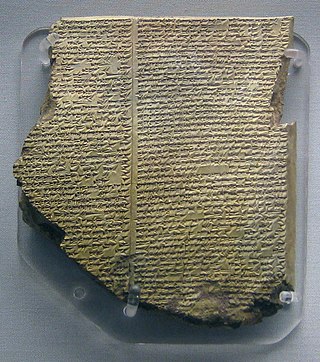
An epic poem, or simply an epic, is a lengthy narrative poem typically about the extraordinary deeds of extraordinary characters who, in dealings with gods or other superhuman forces, gave shape to the mortal universe for their descendants.

Poetry, also called verse, is a form of literature that uses aesthetic and often rhythmic qualities of language − such as phonaesthetics, sound symbolism, and metre − to evoke meanings in addition to, or in place of, a prosaic ostensible meaning. A poem is a literary composition, written by a poet, using this principle.
Ottava rima is a rhyming stanza form of Italian origin. Originally used for long poems on heroic themes, it later came to be popular in the writing of mock-heroic works. Its earliest known use is in the writings of Giovanni Boccaccio.

Cormac McCarthy was an American writer who authored twelve novels, two plays, five screenplays, and three short stories, spanning the Western and postapocalyptic genres. His works often include graphic depictions of violence, and his writing style is characterised by a sparse use of punctuation and attribution. He is widely regarded as one of the greatest American novelists.
The Tower is a book of poems by W. B. Yeats, published in 1928. The Tower was Yeats's first major collection as Nobel Laureate after receiving the Nobel Prize in 1923. It is considered to be one of the poet's most influential volumes and was well received by the public.

The Winding Stair is a volume of poems by Irish poet W. B. Yeats, published in 1933. It was the next new volume after 1928's The Tower.

No Country for Old Men is a 2005 novel by American author Cormac McCarthy, who had originally written the story as a screenplay. The story occurs in the vicinity of the Mexico–United States border in 1980 and concerns an illegal drug deal gone awry in the Texas desert back country. Owing to the novel's origins as a screenplay, the novel has a simple writing style that differs from McCarthy's earlier novels. The book was adapted into a 2007 Coen brothers film of the same name, which won four Academy Awards, including Best Picture.

No Country for Old Men is a 2007 American neo-Western crime thriller film written and directed by Joel and Ethan Coen, based on Cormac McCarthy's 2005 novel of the same name. Starring Tommy Lee Jones, Javier Bardem, and Josh Brolin, the film is set in the desert landscape of 1980 West Texas. The film revisits the themes of fate, conscience, and circumstance that the Coen brothers had explored in the films Blood Simple (1984), Raising Arizona (1987), and Fargo (1996). The film follows three main characters: Llewelyn Moss (Brolin), a Vietnam War veteran and welder who stumbles upon a large sum of money in the desert; Anton Chigurh (Bardem), a hitman who is sent to recover the money; and Ed Tom Bell (Jones), a sheriff investigating the crime. The film also stars Kelly Macdonald as Moss's wife, Carla Jean, and Woody Harrelson as Carson Wells, a bounty hunter seeking Moss and the return of the $2 million.
The following outline is provided as an overview of and introduction to poetry:
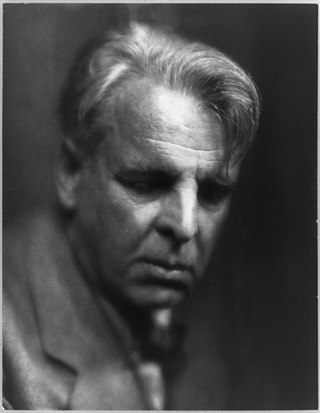
"Politics" is a poem by Irish poet William Butler Yeats written on May 24, 1938. It was composed during the time of the Spanish Civil War as well as during the pre-war period of Adolf Hitler's Third Reich in Germany. The poem hints at the political situations of "Rome" (Italy), "Russia", and Spain, but ultimately discusses topics more relevant to private human interaction rather than public, or political situations. The poem never mentions Germany or Hitler, despite the fact that the "war and war's alarms" surrounding the poem's creation arose from fears of Germany's aggression rather than Italy's, Russia's, or Spain's. Many versions of the text exist: the original typescript of May 1938, the first typescript with hand-written corrections dated August 12, 1938, as well as a final "Coole Edition" of the poem dated June 29, 1939, which was not published until it was included in Last Poems in 1939. Yeats intended for the poem to be printed last in the collection, as an envoi to "The Circus Animals' Desertion", and while a debate as to the true order of the poems has continued since 1939, "Politics" was the last lyric poem Yeats wrote and remains the final work printed in all posthumous editions.

"Ode: Intimations of Immortality from Recollections of Early Childhood" is a poem by William Wordsworth, completed in 1804 and published in Poems, in Two Volumes (1807). The poem was completed in two parts, with the first four stanzas written among a series of poems composed in 1802 about childhood. The first part of the poem was completed on 27 March 1802 and a copy was provided to Wordsworth's friend and fellow poet, Samuel Taylor Coleridge, who responded with his own poem, "Dejection: An Ode", in April. The fourth stanza of the ode ends with a question, and Wordsworth was finally able to answer it with seven additional stanzas completed in early 1804. It was first printed as "Ode" in 1807, and it was not until 1815 that it was edited and reworked to the version that is currently known, "Ode: Intimations of Immortality".
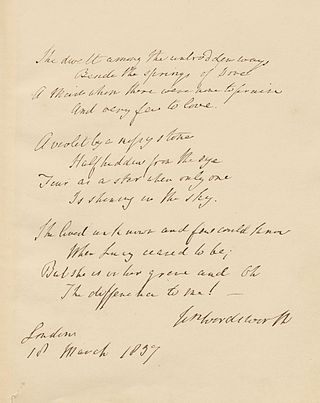
"She Dwelt Among the Untrodden Ways" is a three-stanza poem written by the English Romantic poet William Wordsworth in 1798 when he was 28 years old. The verse was first printed in Lyrical Ballads, 1800, a volume of Wordsworth's and Samuel Taylor Coleridge's poems that marked a climacteric in the English Romantic movement. The poem is the best known of Wordsworth's series of five works which comprise his "Lucy" series, and was a favorite amongst early readers. It was composed both as a meditation on his own feelings of loneliness and loss, and as an ode to the beauty and dignity of an idealized woman who lived unnoticed by all others except by the poet himself. The title line implies Lucy lived unknown and remote, both physically and intellectually. The poet's subject's isolated sensitivity expresses a characteristic aspect of Romantic expectations of the human, and especially of the poet's condition.

The Well Wrought Urn: Studies in the Structure of Poetry is a 1947 collection of essays by Cleanth Brooks. It is considered a seminal text in the New Critical school of literary criticism. The title contains an allusion to the fourth stanza of John Donne's poem, "The Canonization", which is the primary subject of the first chapter of the book.

Rosa Jamali is an Iranian poet, translator, literary critic, and playwright.
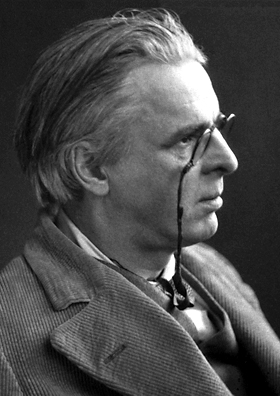
"The Circus Animals' Desertion" is a poem by William Butler Yeats published in Last Poems in 1939. While the original composition date of the poem is unknown, it was probably written between November 1937 and September 1938. In the preface, Yeats suggests that he intended the poem to combine his personal views and impressions with the customs and beliefs of Christian Ireland. The poem was the last work published in Yeats's final collection, with "Politics" following as an envoi. In the poem, the poet uses the desertion of circus animals as an analogy to describe his failure to find inspiration for poetic creation as he seeks for new inspiration. Critics have detected aspects of both Modernism and Postmodern literature in the poem.
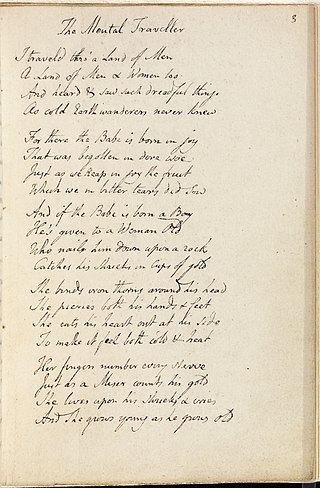
The Mental Traveller is a poem by William Blake. It is part of a collection of unpublished works called The Pickering Manuscript and was written in a manner that suggests the poem was to be read directly from the collection.

The Cumaean Sibyl was the priestess presiding over the Apollonian oracle at Cumae, a Greek colony near Naples, Italy. The word sibyl comes from the ancient Greek word sibylla, meaning prophetess. There were many sibyls throughout the ancient world. Because of the importance of the Cumaean Sibyl in the legends of early Rome as codified in Virgil's Aeneid VI, and because of her proximity to Rome, the Cumaean Sibyl became the most famous among the Romans. The Erythraean Sibyl from modern-day Turkey was famed among Greeks, as was the oldest Hellenic oracle, the Sibyl of Dodona, dating to the second millennium BC according to Herodotus, favored in the east.
"To the Rose upon the Rood of Time" is poem by W. B. Yeats that was published in The Rose in 1893. The poem is one of many early Yeatsian lyrical poems which utilize the symbol of the rose.
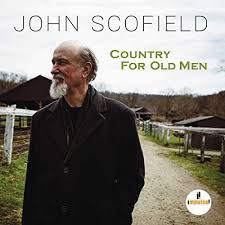
Country for Old Men is an album by American jazz guitarist John Scofield. It earned Scofield a Grammy Award for Best Jazz Instrumental Album. It features longtime Scofield collaborators Larry Goldings on piano & organ, bass guitarist Steve Swallow and drummer Bill Stewart. Impulse! released the album on September 23, 2016.

"Sailing to Byzantium" is a novella by the American writer Robert Silverberg. It was first published in Asimov's Science Fiction in February 1985, then in June 1985 with a book edition. The title is from the poem of the same name by W. B. Yeats. The story, like the poem, deals with immortality, and includes quotations from the poem.














